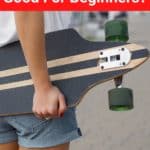As I flipped through TV channels one rainy day, I came across a sports show that caught my attention and made me pause.
The camera was following a man on a longboard as he flew down a winding, paved road.
He glided around turns with ease and made all of the movements look effortless.
As someone with minimal balance and no skills on a skateboard, I immediately thought that riding a longboard looked difficult.
As I heard the rain continue outside, I wondered if longboarding was even possible in the rain.
I decided to do some research and see if longboarders frequently attempted to ride during drizzly weather.
So, what is the answer to “can you longboard in the rain?”
Yes, you can longboard in the rain. If you make a few adjustments to the setup and maintenance of your board, you can enjoy an outdoor ride even when the weather is not so sunny.
So, do you need to be a professional to longboard in the rain?
What kind of preparation does your longboard need? How can you longboard in the rain safely?
We will answer all of these questions and more to help you prepare for a great ride.
Let’s get right to it:
Can anyone longboard in the rain?
Do you need to be a professional longboarder in order to attempt riding in the rain?
The answer is no, almost anyone can ride in the rain regardless of their level of expertise.
Professionals or long-term riders have an advantage.
They have more experience and know how their board behaves in a wider variety of riding environments.
However, riding in the rain can be beneficial for beginners, too.
The best way to learn is to try, and longboarding in the rain can help a rider further develop their skills.
Sliding is a good move to practice in the rain.
The wet pavement becomes slick, which makes it easier to break into a slide on your longboard than on a dry surface.
Everyone, but especially beginners, can use this to their advantage and hone their skills.
Can you damage your longboard by riding in the rain?
Yes, you can damage your longboard by riding in the rain.
If your board is not waterproof, or you do not perform the appropriate before and aftercare, it can cause water damage to the bearings and deck.
The bearings of your board can rust if they get wet and are not cleaned and dried afterward.
This can result in the wheels of your board not rolling as smoothly or as fast.
Rust also shortens the lifespan of the bearings, so they will need to be replaced more often if they are not cared for properly.
The deck of the longboard can bend, or warp, if the edges are not sealed to water and it is absorbed by the ply.
The deck can also de-laminate and the layers of the board can start to come apart.
This can create dangerous riding conditions
How can you prevent water damage to your longboard when riding in the rain?
There are a couple easy ways to prevent water damage to your longboard if you ride in the rain.
The first step to prevent water damage to your board is to care for the bearings and other metal pieces.
After coming in from a ride in the rain, take the board apart and dry the metal parts with a rag.
You can use a blow dryer to get even more moisture off of both the metal and deck.
Clean, dry, and lubricate the bearings to ensure that they do not rust.
If you do not want to worry as much about aftercare, you could invest in ceramic bearings which are waterproof.
It is still beneficial to disassemble and dry your longboard after a ride in the rain.
The next step is to make sure that the deck of your longboard is sealed off to the water.
All edges, scratches, or other openings should be covered with a sealant.
Polyurethane makes a good sealant that you can apply yourself.
The entire deck needs to be sealed, even the part that is underneath the grip tape.
Do no put a sealant over the grip tape of the deck as it can be very dangerous.
What wheels are best for riding your longboard in the rain?
The wheels that you use to longboard in the rain can have a big effect on your safety and control of the board.
You can buy wheels that are specifically made for riding on wet surfaces and in the rain, or you can buy wheels with similar specs.
Wheels that are designed for use on wet pavement have a 70mm or larger diameter and 49mm or larger width to increase the area of contact between the wheel and pavement.
Square-lipped, or square-edged, wheels have better grip than round-lipped wheels.
Wheels that are stoneground are also recommended.
This allows you to slide more smoothly on your board and prevents the wheels from catching if you hit a dry patch.
The smoother ride allows you to have more control.
You can buy wheels that are specifically made for riding on wet surfaces or in the rain.
These wheels may have grooves to maximize their grip on the pavement.
How do you safely longboard in the rain?
Riding your longboard in the rain can be a great way to improve your skills as a rider and have a great time!
However, it is important to prioritize safety and make sure you are taking all the necessary precautions.
A helmet is absolutely necessary for longboarding, whether it is raining or not.
Even at low speeds, a helmet can save a rider from serious injuries if they fall or crash.
Make sure that your helmet is fitted properly and has a buckle to keep it secured.
Knee and elbow pads are also recommended.
Make sure that the grip tape on the deck is clean.
If it is dirty, you can lose your grip and your foot can slip on the board.
This can result in a fall.
It is not recommended to ride a longboard on a downhill in the rain.
Your board’s grip is not as good as on dry pavement, and a slip may cause you to crash.
If you are speeding down a hill, it could result in more serious injuries than a crash on a flat path at a slower speed.
While beginners can ride their longboards in the rain, it is important that you know how to safely turn and stop.
Do not try to learn the basics of longboarding on wet pavement.
Be sure that you have a good foundation before attempting to ride in the rain.
This includes knowing how to fall safely to avoid wrist, knee, or other joint injuries.
Yes, you can longboard in the rain.
It can be a fun and useful learning experience for both beginners and professionals, but you must take the proper safety precautions.
Beginners should be comfortable with the basics of longboarding, such as stopping and falling safely, before trying to ride and practice sliding in the rain.
All levels of expertise should wear safety gear and be mindful of their surroundings while riding.
It is also important that you take care of your longboard before and after riding it in the rain by waterproofing, cleaning, and drying it.
This improves your board’s lifespan so you can take it on many more rainy adventures!







